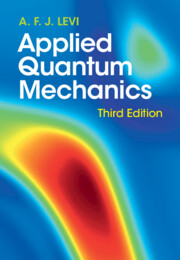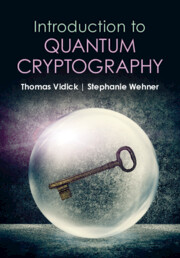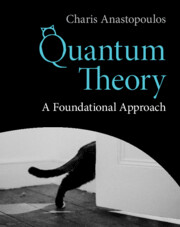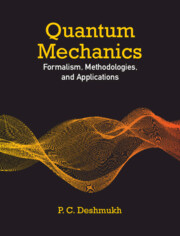Refine search
Actions for selected content:
3336 results in Quantum Physics, Quantum Information and Quantum Computation
Contents
-
- Book:
- Introduction to Quantum Mechanics
- Published online:
- 15 May 2024
- Print publication:
- 16 November 2023, pp vii-xiv
-
- Chapter
- Export citation

Applied Quantum Mechanics
-
- Published online:
- 27 October 2023
- Print publication:
- 31 August 2023
-
- Textbook
- Export citation

Introduction to Quantum Cryptography
-
- Published online:
- 10 October 2023
- Print publication:
- 14 September 2023
-
- Textbook
- Export citation

Quantum Theory
- A Foundational Approach
-
- Published online:
- 06 October 2023
- Print publication:
- 31 August 2023
-
- Textbook
- Export citation
Chapter 4 - Solutions of the Schrödinger Equation in Three Dimensions
-
- Book:
- Quantum Mechanics with Concept Maps
- Published online:
- 07 September 2023
- Print publication:
- 21 September 2023, pp 95-126
-
- Chapter
- Export citation
Contents
-
- Book:
- Quantum Mechanics with Concept Maps
- Published online:
- 07 September 2023
- Print publication:
- 21 September 2023, pp vii-x
-
- Chapter
- Export citation
Copyright page
-
- Book:
- Quantum Mechanics with Concept Maps
- Published online:
- 07 September 2023
- Print publication:
- 21 September 2023, pp iv-iv
-
- Chapter
- Export citation
Chapter 3 - Bra-ket Notation
-
- Book:
- Quantum Mechanics with Concept Maps
- Published online:
- 07 September 2023
- Print publication:
- 21 September 2023, pp 67-94
-
- Chapter
- Export citation
Chapter 2 - Solutions of the Schrödinger Equation in One Dimension
-
- Book:
- Quantum Mechanics with Concept Maps
- Published online:
- 07 September 2023
- Print publication:
- 21 September 2023, pp 35-66
-
- Chapter
- Export citation
Chapter 1 - Fundamentals
-
- Book:
- Quantum Mechanics with Concept Maps
- Published online:
- 07 September 2023
- Print publication:
- 21 September 2023, pp 1-34
-
- Chapter
- Export citation
Chapter 6 - Mathematical Background
-
- Book:
- Quantum Mechanics with Concept Maps
- Published online:
- 07 September 2023
- Print publication:
- 21 September 2023, pp 135-169
-
- Chapter
- Export citation
Glossary
-
- Book:
- Quantum Mechanics with Concept Maps
- Published online:
- 07 September 2023
- Print publication:
- 21 September 2023, pp 170-171
-
- Chapter
- Export citation
Notation
-
- Book:
- Quantum Mechanics with Concept Maps
- Published online:
- 07 September 2023
- Print publication:
- 21 September 2023, pp xv-xvi
-
- Chapter
- Export citation
Preface
-
- Book:
- Quantum Mechanics with Concept Maps
- Published online:
- 07 September 2023
- Print publication:
- 21 September 2023, pp xi-xii
-
- Chapter
- Export citation
Index
-
- Book:
- Quantum Mechanics with Concept Maps
- Published online:
- 07 September 2023
- Print publication:
- 21 September 2023, pp 172-173
-
- Chapter
- Export citation
Dedication
-
- Book:
- Quantum Mechanics with Concept Maps
- Published online:
- 07 September 2023
- Print publication:
- 21 September 2023, pp v-vi
-
- Chapter
- Export citation
Chapter 5 - Approximation Methods
-
- Book:
- Quantum Mechanics with Concept Maps
- Published online:
- 07 September 2023
- Print publication:
- 21 September 2023, pp 127-134
-
- Chapter
- Export citation
Instructions
-
- Book:
- Quantum Mechanics with Concept Maps
- Published online:
- 07 September 2023
- Print publication:
- 21 September 2023, pp xiii-xiv
-
- Chapter
- Export citation

Quantum Mechanics
- Formalism, Methodologies, and Applications
-
- Published online:
- 14 September 2023
- Print publication:
- 04 January 2024
7 - Distributing Keys
-
- Book:
- Introduction to Quantum Cryptography
- Published online:
- 10 October 2023
- Print publication:
- 14 September 2023, pp 176-193
-
- Chapter
- Export citation
